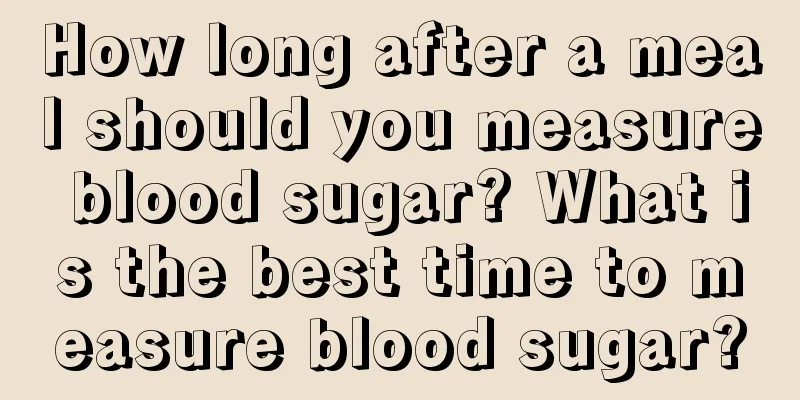How long after a meal should you measure blood sugar? What is the best time to measure blood sugar?

|
There are more and more diabetic patients nowadays, which has a lot to do with daily diet. Diabetes is very harmful and can be fatal. Therefore, the most important thing for diabetic patients is to test blood sugar, especially blood sugar after meals. 1. When is the best time to test blood sugar? 1. Fasting blood sugar. Generally choose to check between 6 and 8 in the morning. It mainly reflects the basal level of insulin secretion by the patient's own pancreatic islet cells in the absence of a glucose load, as well as the control of blood sugar throughout the night by the medications used the night before. Control of fasting blood sugar is very important for patients who use hypoglycemic drugs for a long time. However, for patients with early or mild diabetes, even if the fasting blood sugar is lower than 7.0 mmol/L, they should pay attention to the blood sugar level 2 hours after a meal. 2. Blood sugar before meals. Measure before lunch or dinner. It can be used as a basis for evaluating the condition and adjusting drug dosage during treatment. Blood sugar 2 hours after 3 meals. Check blood sugar 2 hours after eating. It mainly reflects the ability of pancreatic islet cells to secrete insulin after a meal, as well as the combined effect of diet and drug treatment. 4. Blood sugar before bed. Measuring blood sugar before bed can guide nighttime medication dosage and avoid nocturnal hypoglycemia. 5. Blood sugar at 3 am. It is possible to distinguish whether high fasting blood sugar is caused by the dawn phenomenon or the Somogyi phenomenon. If the blood sugar level is lower than 3.6 mmol/L at this time, hypoglycemia may occur at night. 2. So, what should you pay attention to when measuring blood sugar? 1. It is best to collect the second drop of blood. The first drop of blood may be contaminated with other substances and affect the reading. For example, peeling fruit or drinking juice from a cup before measuring blood sugar will make the blood sugar value higher. In addition, the amount of the first drop of blood is too small. If there is not much bleeding after pricking the finger, the blood glucose meter often cannot accurately display the reading; if you squeeze the finger hard, the tissue fluid and blood will be mixed, resulting in a low blood sugar value. 2. Make preparations before testing. Avoid strenuous exercise, smoking and drinking stimulant beverages before blood drawing. Before measuring blood sugar, let your arms hang down for 10 seconds, or shake or rub your hands for half a minute to allow the blood vessels at the fingertips to fill. People who are afraid of pain can draw blood from the side of their finger, which will not be so painful. In addition, you need to wash your hands first, otherwise it will increase the chance of infection and the blood sugar value may be higher due to the sugar content on your hands; if it is inconvenient to wash your hands before measuring blood sugar, you can wipe your fingertips with alcohol and let them dry for 5 to 10 seconds before drawing blood. 3. Pay attention to the testing time. The best time to test fasting blood sugar is between 6 and 7 in the morning, when patients often have not eaten all night; but if blood is drawn on an empty stomach after 9 o'clock, the accuracy of fasting blood sugar will be lost. The best time to test postprandial blood sugar is 2 hours after a meal, because the peak of postprandial blood sugar often occurs 2 hours after a meal. Measuring blood sugar at midnight and 3 a.m. can identify the cause of fasting hyperglycemia, because both insulin deficiency and excessive insulin dosage at night can cause fasting hyperglycemia. 4. Don’t ignore glycated hemoglobin. Glycated hemoglobin reflects the average blood sugar level in the past three months, and finger blood sugar reflects the blood sugar at the "point in time" when the blood sugar is measured. Diabetic patients cannot just measure blood sugar on their fingertips, but also need to regularly measure glycosylated hemoglobin and monitor other metabolic indicators such as blood lipids and uric acid to comprehensively assess the patient's diabetes control status. 5. Daily medication should continue as usual. To ensure the authenticity and reliability of the test results, patients undergoing diabetes treatment should eat and take medications as usual one day before the test. They should not stop taking hypoglycemic drugs without authorization, otherwise the test results will not accurately reflect the condition and will cause blood sugar fluctuations and aggravate the condition. |
<<: What to do if you have itchy bumps due to allergies? Diet therapy is effective
>>: Is blood sugar level of 8.8 normal after a meal? Experts tell you
Recommend
Homemade serum recipe
You can also make the essence yourself. Its formu...
8 Misleading Health Rumors: Drink White Wine When You Feel Cold?
Eating black fungus regularly can clear the lungs...
What are the reasons for sweating after drinking water in summer
In the summer, many people will sweat right after...
Possible causes of bone cancer
The causes of bone cancer may include multiple fa...
Red blisters on hands
If you feel a lot of red blisters on your hands, ...
How to open the canned yellow peach bottle skillfully
Yellow peach has a smooth texture, sweet taste, a...
What's up with the golden beard
Human hair has many different colors, and these c...
What foods are good for frozen shoulder?
Patients with periarthritis of the shoulder shoul...
Can I eat durian after having my thyroid cut in half?
You can eat durian after hemisection of the thyro...
What is the clay formula? Professionals are here to introduce!
Maybe some people don’t know what colored clay is...
Why does your face turn yellow if you wash it with calendula water for a long time?
Calendula, also known as Marigold, is a relativel...
Indications for various treatments for gastric cancer
Common treatments for gastric cancer include surg...
How to use Tooth Guard? Just look below to find out
Tooth Mousse is designed to protect teeth. The mi...
Can endometrial cancer during pregnancy be cured?
Endometrial cancer is a malignant tumor. It is ge...
How much lotus leaves can be soaked at one time
Lotus leaf is a common aquatic plant leaf, and it...









